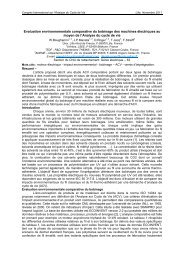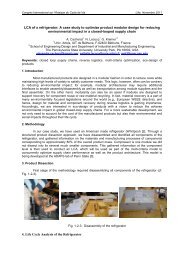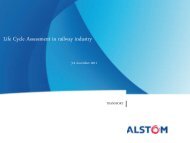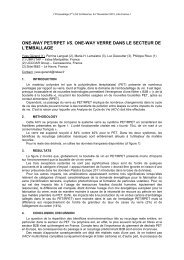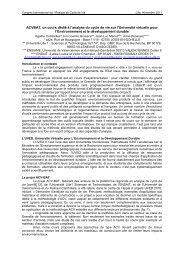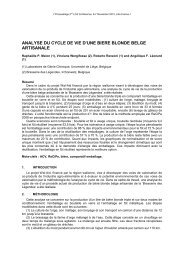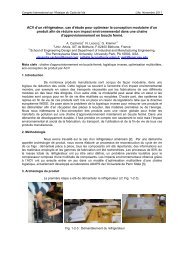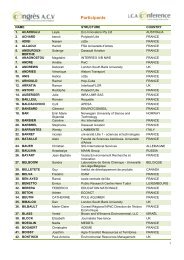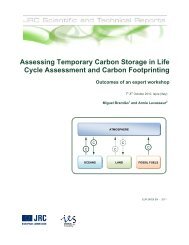Untitled - avniR
Untitled - avniR
Untitled - avniR
Create successful ePaper yourself
Turn your PDF publications into a flip-book with our unique Google optimized e-Paper software.
Congrès International sur l’Analyse du Cycle de Vie Lille, Novembre 2011<br />
A CARBON FOOTPRINT STUDY OF A REMANUFACTURED AND/OR REFURBISHED<br />
RETAIL REFRIGERATED DISPLAY CABINET<br />
D. Bibalou*, I. Chaer*, D. Andrews*, G. Maidment* and M. Longhurst **<br />
* Faculty of Engineering and Built Environment, London South Bank University, 103 Borough Road,<br />
London, SE1 0AA, UK; email: bibaloud@lsbu.ac.uk<br />
** The Bond Group, Bond House, New Road, Sheerness, Kent, ME12 1BB<br />
Introduction:<br />
In 2010, the UK had 7970 supermarkets (IGD Research, 2010), which were using, in 2010, almost<br />
800,000 refrigerated display cabinets (RDC). According to literature, RDCs account for 33% of<br />
supermarkets’ energy bills; their lifespan is also shrinking partly as a consequence of the entry to the<br />
market of inexpensive models. Therefore, assessing and managing the RDC’s life cycle will lead<br />
to reductions in CO2 emissions. This document’s purpose is to quantify the emissions by looking at the<br />
underused practices of refurbishing and remanufacturing RDCs (12.5% in the UK).<br />
Method:<br />
This carbon footprint study is based on life cycle thinking and uses the eco-design software: CES<br />
selector/ Eco-audit. The data were collected as followed: Bill of materials (BOM) inspections, followed by<br />
RDC disassembling for verification and finally energy audits of the manufacturing partner’s factories. The<br />
RDC studied is a 1.2m plug-in multi-deck Chicago model manufactured by the Bond Group, with a total<br />
mass of 360kg. Figure 1 is a rendered picture of the Chicago whereas figure 2 shows the same cabinet<br />
being disassembled. Moreover, table 1 presents a partial BOM with alternative end-of-life (EoL) scenarios.<br />
Figure 8 Chicago 1.2m rendered picture<br />
Figure 9 The Chicago RDC being dismantled<br />
Table 4 Partial BOM of the Chicago 1.2 with EoL scenarios<br />
Materials<br />
∑Mass (kg) Proportion (%) EoL scenario 1 EoL scenario 2<br />
aluminium 4.59 1.27 Recycled Refurbishment<br />
Aluminium, S332.1: LM26-TE, cast 12.4 3.44 Recycled Refurbishment<br />
ASTM CA-6NM 13 3.61 Recycled Refurbishment<br />
Copper 9.915 2.75 Recycled Refurbishment<br />
Mdf 34.9 9.69 combust combust<br />
Polyurethane 14.29 3.97 landfill landfill<br />
R404A (refrigerant) 1.2 0.33 N/A N/A<br />
Soda-lime 0080 (glass) 44 12.22 Recycled Refurbishment<br />
Stainless steel grade 304 45.08 12.52 Recycled Refurbishment<br />
Galvanised steel (zintec) 175.15 48.64 Recycled Refurbishment<br />
Two EoL scenarios are presented, firstly, all metallic parts are recycled at EoL and a secondly, all<br />
metallic components are either remanufactured or refurbished. Various simplifying assumptions were<br />
made, for instance, secondary manufacturing processes (e.g. mechanical wear of components) were<br />
ignored, and only the refrigerant’s embodied energy is considered (its global warming potential being<br />
3922).<br />
53



